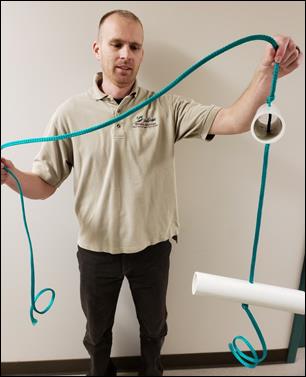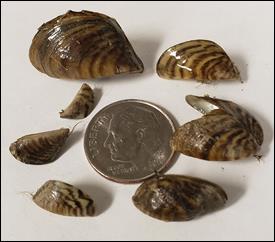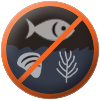South Dakota Citizen Monitoring
Zebra and quagga mussels have the potential to cause substantial economic and ecological harm once they invade new waters. Monitoring for zebra and quagga mussels is one of the best methods for preventing their spread between waterbodies. Therefore, the South Dakota Game, Fish and Parks is partnering with the public through the Citizen Monitoring program to monitor for adult mussel presence on easy-to-use PVC sampling devices. Citizen monitoring for invasive species can increase the number of waters monitored in the state and allows a rapid response to new infestations by Game, Fish and Parks.
Report Findings
Materials needed to build a sampler:
- Two 1-foot sections of 1.5”-2" PVC pipe
- 10 feet of 5/16” polypropylene rope
- One brick or other weighted object
How to build a sampler:
- Six inches from one end, drill holes through the top and bottom of the PVC pipe sections using a 1/2" drill bit
- Tie an overhand knot roughly 1.5 feet from one end of the rope.
- Thread the rope from the untied end through the holes drilled in one piece of pipe. Slide the pipe down the rope until it hits the knot.
- Tie another knot approximately 1.5 feet above the first pipe, and thread the second piece of pipe down the rope until reaching the knot.
- Tie a final knot directly above this second pipe to prevent it from moving up or down along the rope.
- If necessary, burn the ends of the rope with a lighter to prevent the strands from unravelling.

PVC dock samplers offer a simple and inexpensive method for the public to get involved in monitoring for zebra and quagga mussels in South Dakota waters.
Steps for deploying a sampler:
- Tie the short end of the rope to a brick or similar weighted object.
- Tie the long end of the rope near the end of the dock so that the line stays tight and the bottom pipe section is approximately 1 foot above the lake bottom.
Zebra Mussel Biology
- Zebra mussels can begin to reproduce in May in South Dakota waters. Adults can reach 2 inches in length, but juveniles are much smaller. Zebra mussel shells are triangular or “D”-shaped and typically have stripes.
- Unlike native mussels, Zebra mussels are able to permanently attach directly to hard surfaces.

Zebra mussel shells with a dime for size comparison.
Monitoring and Reporting
- The samplers should be checked once per month from July, August and September.
- Printable Instructions
- Please report all sampler checks, even if you don’t see any mussels, by clicking Report Findings.
If you would like to participate in the citizen monitoring program and would like a sampler, please contact Tanner Davis, Statewide AIS Coordinator, at tanner.davis@state.sd.us or call 605.367.5244.
For additional information please contact:
Tanner Davis| AIS Coordinator
4500 S. Oxbow Ave, Sioux Falls, SD 57106
605.367.5244 | Tanner.Davis@state.sd.us



